









The Sequels
April 20, 2006 - Post No. 59
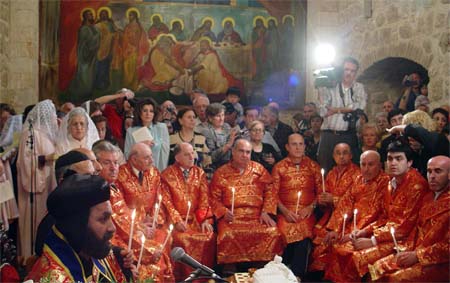
The foot washing ritual in the Syrian chapel of the
Upper Room.
The hospitality of Bishop Clive and Jane Handford in Nicosia, including a
day trip yesterday to explore the Cypriot countryside (a Judas tree in
full bloom, pictured here), was a
welcome break before going on to Jerusalem. Bishop Clive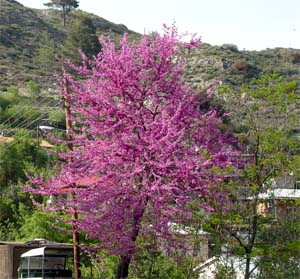 drove me to the
airport in Larnaca, and kindly waited with me, to ensure that my travel
arrangements were all in order, in a rather packed line of passengers
checking in for the late night flight to Tel Aviv. Once boarding pass in
hand, we bid farewell and go our separate ways, the good bishop to
return for another couple of days
at home before travelling off again, as is very much the character of
his highly itinerate episcopal ministry; and yours truly to
drove me to the
airport in Larnaca, and kindly waited with me, to ensure that my travel
arrangements were all in order, in a rather packed line of passengers
checking in for the late night flight to Tel Aviv. Once boarding pass in
hand, we bid farewell and go our separate ways, the good bishop to
return for another couple of days
at home before travelling off again, as is very much the character of
his highly itinerate episcopal ministry; and yours truly to
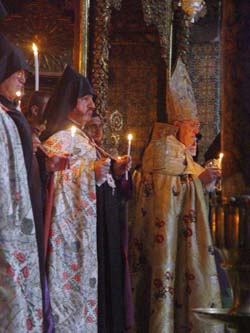 venture on
to the holy if troubled city of Jerusalem.
venture on
to the holy if troubled city of Jerusalem.
Shortly after midnight, I find Father Goossan, music director at the Armenian Patriarchate in Jerusalem, and Kevork, the Patriarchate's driver and general factotum, waiting to collect me in the arrivals area of the new terminal at Ben Gurion Airport in Tel Aviv. As Archbishop Nourhan, pictured centre here beside Patriarch Torkom (right), assured me when we met in Antelias, everything has been arranged for my stay in Jerusalem. After about a 30 minute drive we arrive at the Patriarchate, and Fr. Goossan and Kevork help me transfer my luggage to my room in the Monastery of SS. James.
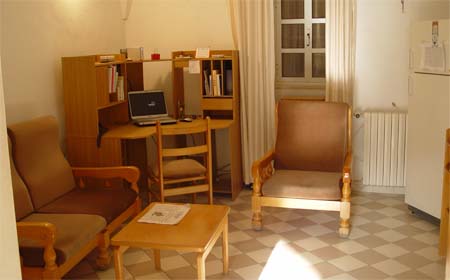
My quarters are more than suitable, quite luxurious really, one might say a suite of rooms, a two and a half, as the Quebeckers call it (a combined living room and kitchen, a bedroom and en suite bathroom with a shower.) The Monastery is part of the 300 acre track of land known as the "Armenian Quarter" within the walls of Old Jerusalem. The Patriarchate itself takes up about two thirds or more of the Armenian Quarter with its cathedral, two other churches, the 365 room monastery, the seminary, a museum, and several other buildings -- including stables that could once accommodate up to a thousand horses -- all amid a maze of courtyards and pathways.
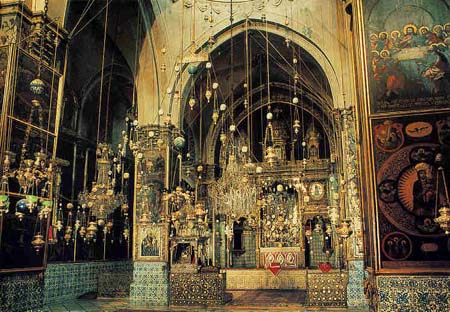
The interior of the Armenian Cathedral of SS. James,
Jerusalem
The Cathedral of Saints James is one of the most beautiful and venerable churches in the Christian world. The current building dates from the mid-twelfth century and is dedicated to Saint James the Less, the brother of our Lord and first Bishop of Jerusalem, and to Saint James the Greater, the apostle, one of the two brothers of Zebedee. St. James the Less is buried here and the Cathedral stands on the traditional site of his home -- where the first council of the church took place in 49 A.D. The head of the St. James the Greater is here, his body is in the great pilgrimage church of Santiago (Saint James) de Compostella in Spain.
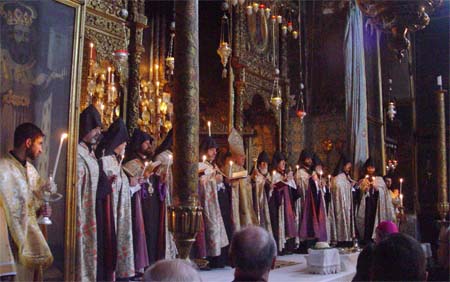
Arriving in Jerusalem, I have fallen back in time to Holy Week all over again. The eastern and western churches have different systems, both dependent on lunar cycles, to set the date for Easter. Most of the Armenian Orthodox around the world, in a gesture of unity, have opted for the date used in the west, but in Jerusalem, the Armenians have little choice but to keep pace with the other orthodox communities in the Holy City.
Today is Great Thursday and the main event of the day here, as it was in Antelias, is the ritual of the Foot Washing. The service begins at 2:30 p.m. and I've been told to arrive at least half an hour early to find a seat. I claim a space on a bench inside the Tas (the chancel area) and watch as the cathedral fills in with visitors.
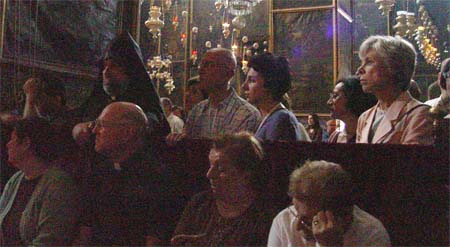
In addition to various dignitaries attending the popular event, there are about 700 Armenian pilgrims from all around the world, and a group from St. George's College, the Anglican continuing education centre in Jerusalem.
Each year the college offers a programme focused on the liturgies of Orthodox Holy Week and Easter in and around Old Jerusalem. The course is called the "Holy Fire" and the Great Thursday Foot Washing is a main event on the course's calendar. Today, the group attends three foot washings in fact, joining the service at the Greek Patriarchate in the morning, then the Armenians in the early afternoon, and finally the late afternoon foot washing at the Syrian Orthodox monastery.
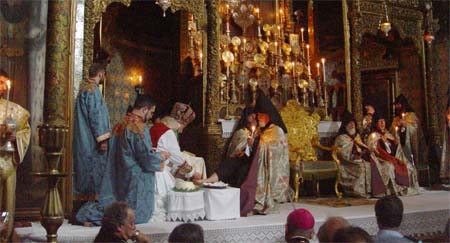
The ritual at the Patriarchate follows the same order as the one last week at the Catholicosate in Antelias. Hymns, prayers, and finally the liturgical re-enactment of the foot washing that took place at the last supper, the night before the crucifixion. Pictured above, wearing the crown of the king who stoops to wash the feet of his subjects, Patriarch Torkum presides at the liturgy. His Beatitude is in his late eighties, and there is some concern that he will soon have to give this task to a younger bishop.
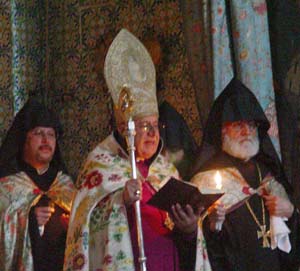 Near
the conclusion of the ritual, it is the custom here to invite the bishop
of the Anglican Diocese of Jerusalem, Bishop Riah (pictured here) to
read the English translation of John 13.1-17. The ties between the
Armenian and Anglican communities here are quite cordial, and I learn
later that the local Anglicans join the Armenians when it is time for
the famous (or infamous) liturgy of the Holy Fire in the Church of the
Resurrection on Great Saturday.
Near
the conclusion of the ritual, it is the custom here to invite the bishop
of the Anglican Diocese of Jerusalem, Bishop Riah (pictured here) to
read the English translation of John 13.1-17. The ties between the
Armenian and Anglican communities here are quite cordial, and I learn
later that the local Anglicans join the Armenians when it is time for
the famous (or infamous) liturgy of the Holy Fire in the Church of the
Resurrection on Great Saturday.

Following the service, I enjoy meeting Anne Barker, one of the participates in the St. George's College course. She is admiring the textiles in the Cathedral, and explains that as a member of her parish altar guild in her native England, she is curious about the fabrics and vessels used for the service.
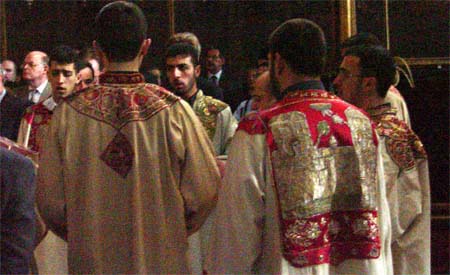
The great sanctuary curtain (a corner of which can be seen to the right
of Anne, in the photo above) is decorated with stitched silk medallions
and patterns, featuring images of Jesus, Mary Mother of God, and some of
the saints. There is a massive piece of lace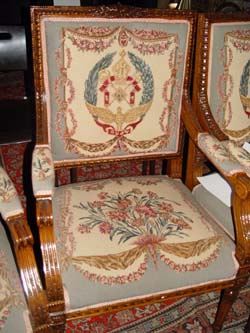 trimmed linen used once a year for the foot washing, to cover the floor
of the raised sanctuary bema; and Bishop Nourhan tells me that some of
the vestments bear needle work that is centuries old.
trimmed linen used once a year for the foot washing, to cover the floor
of the raised sanctuary bema; and Bishop Nourhan tells me that some of
the vestments bear needle work that is centuries old.
I comment that I like to photograph church textiles to share with the team of needle workers at my home Cathedral in Quebec City; and Anne suggests that I should certainly take a photograph of one of the upholstered chairs reserved for the dignitaries attending the foot washing service today. "All court point and wonderful," she affirms.
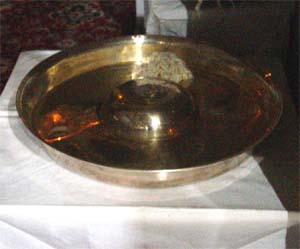 We
also take interest in the silver basin used for the foot washing today.
Not quite as elaborate as the one in Antelias, its design is still quite
interesting and very practical in terms of its specific purpose. Like
the one in Antelias, it features a mound in the centre that serves as a
foot rest during the washing of the feet.
We
also take interest in the silver basin used for the foot washing today.
Not quite as elaborate as the one in Antelias, its design is still quite
interesting and very practical in terms of its specific purpose. Like
the one in Antelias, it features a mound in the centre that serves as a
foot rest during the washing of the feet.
Following a tip from Anne, a few minutes after the end of the Armenian foot washing, I set out to attend the same service again (number 3!) but this time with the Syrian Orthodox community at the Monastery of St. Mark, the much smaller monastic neighbour of the Armenians.
Catching sight of my cassock, the lay officials at the door of the
monastery send me up a double flight of stairs to join a gathering of
dignitaries (for the most part Anglican clergy!)
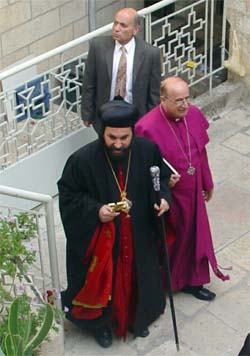 waiting
in the salon or receiving room of the monastery. Among them a Syrian
bishop on pilgrimage with a group from his diocese in New Jersey.
Surprisingly, he knows all about my "blog" -- I gather my reports from
the Syrian Patriarchate in Damascus (see week
eight) have made the tour of the Syrian world!
waiting
in the salon or receiving room of the monastery. Among them a Syrian
bishop on pilgrimage with a group from his diocese in New Jersey.
Surprisingly, he knows all about my "blog" -- I gather my reports from
the Syrian Patriarchate in Damascus (see week
eight) have made the tour of the Syrian world!
Once again I find Bishop Riah, pictured here with the Syrian Archbishop of Jerusalem. I join the group of visitors in a procession that takes the Syrian Archbishop through the crowded monastic courtyard to the tiny chapel where he will preside at the liturgy of the foot washing.
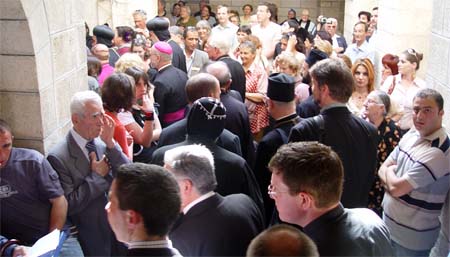
Accessing to the chapel here is described as "going down to the Upper Room." The Syrians believe this to be the site of the Last Supper of Jesus (there is a Latin rite chapel, not far away, that makes the same claim) and they explain that the street has risen (built up on layer-after-layer of debris over the centuries) so that what once was "upper" is now found down below street level, down a short flight of stairs. It is particularly impressive to gather for this liturgy where the original event might well have taken place.
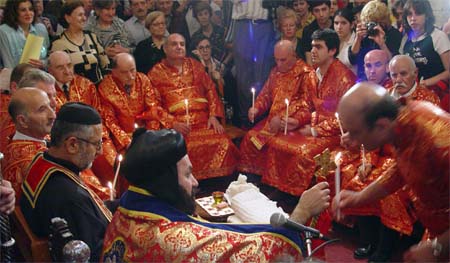
After an introductory series of hymns and prayers, the foot washing
begins with the presentation of the followers of Jesus. The Archbishop
introduces each,
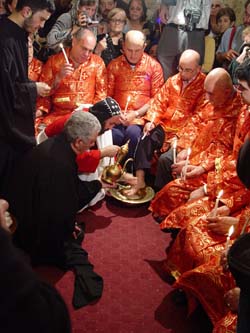 with
a priest in the role of Saint Peter and deacons and acolytes
representing the other disciples. The group sit on three benches
arranged in a U shape, in the centre of the chapel, below the chancel
steps.
with
a priest in the role of Saint Peter and deacons and acolytes
representing the other disciples. The group sit on three benches
arranged in a U shape, in the centre of the chapel, below the chancel
steps.
Like the Anglican liturgies I have seen, the celebrant moves from disciple to disciple for the washing of the feet -- the Armenians come to the celebrant, one-by-one to have their feet washed. The priest representing St. Peter is the last to have his feet washed, and the washing comes to a halt for the conversation between Jesus and the disciple Peter, read by the Archbishop and the priest in the role of Peter.
He came to Simon Peter, who said to him, ‘Lord, are you going to
wash my feet?’
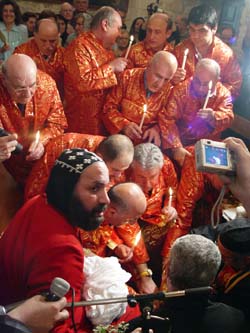 Jesus answered, ‘You do not know now what I am doing, but
later you will understand.’
Peter said to him, ‘You will never wash my feet.’ Jesus
answered, ‘Unless I wash you, you have no share with me.’
Simon Peter said to him, ‘Lord, not my feet only but also my
hands and my head!’
Jesus said to him, ‘One who has bathed does not need to
wash, except for the feet,
but is entirely clean. ..."
Jesus answered, ‘You do not know now what I am doing, but
later you will understand.’
Peter said to him, ‘You will never wash my feet.’ Jesus
answered, ‘Unless I wash you, you have no share with me.’
Simon Peter said to him, ‘Lord, not my feet only but also my
hands and my head!’
Jesus said to him, ‘One who has bathed does not need to
wash, except for the feet,
but is entirely clean. ..."
Once the Syrian Archbishop has completed the washing, the disciples rise as a group and gather to wash one of the Archbishop's feet, to return his gesture, a sign of the Church accepting the mandate to serve as Jesus served. This reciprocation is a somewhat complicated task within the confines of the very small chapel.
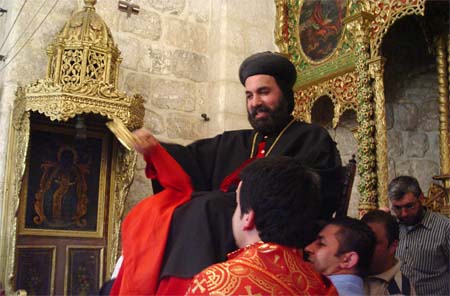
The limited space becomes particularly evident when, at the close of the liturgy, the Archbishop is lifted, while seated on his throne, above the heads of the throng. He leads the concluding prayers, gives his archiepiscopal blessing, and is then given a friendly jostle in the air amid the vibrato cries of the Syrian women in the congregation. Click here for a short movie (4.3MB) of this "uplifting" experience!

Pictured here, a young deacon from the largest branch of the Syrian Orthodox family, the Mar Toma Orthodox Christians in the province of Kerala, India. The good cheer evident at the conclusion of the foot washing here, and present in the Armenian celebration as well, provides a pleasant break from the otherwise ponderous atmosphere of Holy Week.
On my way back to the Armenian Patriarchate, I pause to watch the Syrian drum band in their rehearsal room at the end of the small Syrian monastery complex. There practice session can be heard throughout the monastery and into the streets outside ... perhaps they are practicing for one of the processions that lie ahead in this Holy Week.
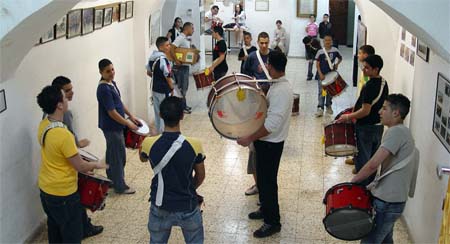
As I work my way back through the narrow walkways of Old Jerusalem to the Armenian monastery, I take the opportunity to have a look around the neighbourhood. I make it back in time for dinner and feel very much the stranger amidst the Armenian monks in the dinning hall. I can't say that I really enjoy "returning to step one" in the social dimensions of my ecumenical pilgrimage -- I miss the sense of familiarity and the many friendships that I have left behind in Antelias. I wonder how long it will take to feel at home again, this time in Jerusalem.
Much later in the evening, I join the Armenian community in the Cathedral of SS. James toward the end of the nearly five hour evening tenebrae marking the Agony in the Garden. It is no easy matter extinguishing the many lamps in the Cathedral, but the deacons are methodical and organised and soon this ancient sacred space is filled with the dark anticipation of the Friday we call Good.